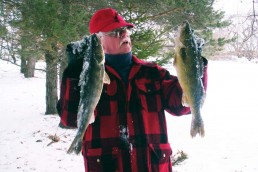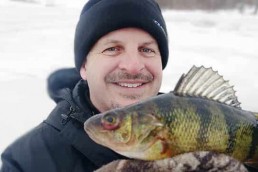Tactics for Overcoming Midwinter Blues
SHARE THIS POST
Winter is long enough in the Ice Belt to be broken into early ice, midwinter and late ice, with the season lasting more than four months in many areas of the region. Most years there is enough ice on the lakes in my part of the country for anglers to drive vehicles on the lakes before the New Year even arrives. I am busy on the “Bro-Road Show” from early November through the Holidays and well into this month. By the time I’m able to get on the ice for my winter guiding season the fish are already starting to settle into their midwinter patterns.
The midwinter portion of the ice fishing season is the least active part of the year for most warmwater species. The metabolism of a fish is at the low point for the year so it doesn’t have to feed nearly as often as it does during the warmer months. The size of the fish and its prey help determine how often it has to eat. If walleyes can find enough larger prey to eat they might be able to grab one big minnow and go several days or longer between feedings. If this species is eating smaller minnows they may have to catch six or more minnows to get a stomach full, which usually means it has to feed longer and more often to get enough to eat.
Walleyes are what fish most anglers want to catch in northern Minnesota, regardless of the time of year. Again, this fish doesn’t have to feed constantly now to get enough to eat so most of them wait for prime time.
This species likes to make feeding movements when hungry, and when they’re active they begin to hunt for food and move to areas where they think minnows are and of the variety and size they want. Once they’re done feeding they’ll go somewhere they feel safe to rest and digest their food.
There are two low-light periods of the day: one at dawn and one at dusk. This means walleyes have two opportunities daily to join other walleyes in a feeding “movement.” There also may be night-feeding movements that occur in many lakes too. Each low-light period will have a portion of the walleye population participating in a feeding movement and a portion of the population will stay behind. There are almost never any movements where all the fish participate, and, there are also very few low-light periods when none of the fish decide to eat.
The weather conditions, amount of forage and how many fish that ate the previous feeding movements will all combine with other factors to determine how many walleyes feed during the next low-light period. More stable weather and pre-frontal conditions means more will feed for a longer period of time, while the unstable or post-frontal weather conditions associated with lows usually means fewer walleyes will feed for a shorter period of time.
Are you enjoying this post?
You can be among the first to get the latest info on where to go, what to use and how to use it!
Smaller fish, like crappies, sunfish and perch, often have to feed more frequently than larger fish like the walleyes and northern pike because they are eating much smaller prey. Perch like to eat insects, crayfish or minnows, while crappies and sunfish often eat microscopic prey, like zooplankton. Smaller fish usually have to feed more often than the larger fish because of the tiny prey they eat.
Anglers fishing during midwinter have to make decisions on where to go and which species to fish for based on the daily weather patterns, the long-range trends and the bite patterns. This may mean changing locations, switching species or even switching up lakes to be able to stay on an active bite all day.
I like a setup of a couple of Frabill Bro-Series Side-Step Houses or Bro Hub Houses on a good contact point for walleyes. I’ll then let my clients fish the morning bite for the walleyes. I’ll usually go scout another spot while clients fish so that I have my next move ready to go when the bite slows down for walleyes. But the best move on most walleye lakes is to target them during low-light periods and then switch to perch and maybe northern pike during the day when these species are the more active ones. Sometimes clients pressure guides to stick with trying to catch walleyes all day, even if a lake doesn’t have a reputation for a good day-bite.
Anglers just need to expect fish to have lower activity levels during midwinter and make their decisions accordingly. Success usually depends on making the right decisions at the right time. The type of lake, the species and types of presentations can all have an impact. Being in the right place at the right time applies to ice fishing. I believe what I see on my unit. If I have fish coming through that won’t bite I need to know for sure what they are. So, then I will drop down an Aqua-Vu Micro5 or other camera because “seeing is believing.” If the fish are indeed walleyes, then I may be in the right place at the wrong time and need to return for the next low-light period these walleyes here are more likely to bite.
I always have multiple rods rigged for different presentations, so I am ready to switch species or change tactics. I use Bro Series rods rigged with 4- or 5-pound-test Sunline FC and use small quick-change snaps so I can change from Puppet Minnows to Buck-Shot Flutter Spoons or smaller Buck-Shot Spoons more quickly.
I also have several deadsticks rigged too if anglers want to fish a second line. I’ll usually rig the deadsticks with a plain glow-colored hook and a split shot and use live minnows. I really love the new Northland Forage Dart when extra finesse is needed to catch fish. These also can be rigged in many different ways with live bait or Impulse Plastics to catch perch, crappies, sunfish, saugers and even finicky walleyes when the conditions get tough.
MWO
SHARE THIS POST
Did you enjoy this post?
You can be among the first to get the latest info on where to go, what to use and how to use it!
Brian 'Bro' Brosdahl
Outdoor communicator Brian “Bro” Brosdahl lives in northern Minnesota. He is a walleye guide in the Cass Lake, Leech Lake and Lake Winnibigoshish areas. He is sponsored by Northland Fishing Tackle, Frabill/Plano, Aqua-Vu, Humminbird/Minn Kota, St. Croix Rods, Ranger Boats, and Evinrude. Guide inquiries: brosguideservice.com. Follow on social media.



